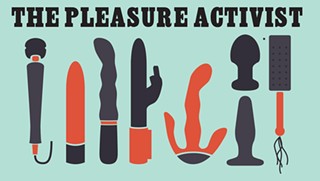Did you learn about the clitoris during a sex ed class? If I were a betting woman, I would say no. If you had a sex ed class at all, you probably saw diagrams of ovaries, fallopian tubes, uteruses and vaginal canals; cross sections of pregnant bellies; and diagrams of penises and testicles in both flaccid and erect states. The clitoris remained a mystery, irrelevant, and/or simply non-existent. Many of us were fortunate to discover this "pleasure nub" through our own explorations, books lying around the house, sex-positive educators or helpful lovers.
But many of us were also not so fortunate, and I deem this a tragedy of epic proportions (you can decide if this hyperbolic or not) considering that according to most statistics 70 to 80 percent of women require direct clitoral stimulation in order to have an orgasm. That is, only 20 to 30 percent of women reach orgasm through vaginal intercourse alone. And out of that 20 to 30 percent, many are reaching orgasm through indirect clitoral stimulation. I would say that makes the clitoris deserving of a feature spot in our sex education curriculum.
1. The clitoris is the only organ whose sole purpose is pleasure. Every other organ that brings us sexual pleasure is also there for other crucial purposes. The vaginal canal serves as a channel for menstrual flow, childbirth and conception (not necessarily in that order). The penis excretes urine and semen. The testicles produce and maintain sperm. Any other organ that brings us pleasure also serves other functions. This makes the clitoris uniquely special as a pure organ of pleasure!
2. There are more nerve endings per square inch on the clitoris than on the penis and possibly twice as many nerve endings then the penis as a whole (but this depends on the source and whether a penis is circumcised or not). There are roughly 8,000 nerve endings. Basically, it has the most nerve endings out of any human body part. In other words, the clitoris is a VERY sensitive and many (most?) women do not like being stimulated directly on the glans (as opposed to over the hood) of the clitoris. This is for the specific clitoris owner to decide, though. And speaking of glans versus hoods...
3. The clitoris is comprised of several different parts. It is more than just a little pea-sized nub protruding above the vaginal opening. The entire body of the clitoris resembles a wishbone shape. That nub is called the "glans" which is either fully or partially sheathed by a fold of skin referred to as the hood. This is the visible portion of the clitoris. The glans is the tip of the body of the clitoris that extends a couple centimeters up before descending into inverted "V" shape legs called the crura. The body of the clitoris surrounds erectile tissue. Then there are the vestibular bulbs that are behind the labia and are adjacent to the crura. These bulbs are also comprised of erectile tissues that engorge when aroused.
Basically, the next time you hear someone refer to a clitoris as a "button," let's hope that they don't actually treat it as such. For all you penis owners out there, would you enjoy being repeatedly poked at the tip of your penis?
4. The clitoris and penis are considered homologous. That is, until about 8 or 9 weeks after conception, they were identical in their pre-developed state as the genital tubercle. As such, many aspects of the clitoris and penis are biological parallels.
Clitoral glans - penile glans (head of penis)
Crura (clitoral legs) – spongy tissue within shaft of penis
Hood – Foreskin
Labia Majora – Scrotal sac
Labia Minora – Skin of the penis
And here's a bonus round:
Ovaries – Testes
Skene's Gland – Prostate
Perineum – Perineum
Anus – Anus
5. Princess Marie Bonaparte (great grand-niece of Napoleon), was a French psychoanalyst linked closely with Freud. Based on her own research of measuring the distance between the clitoris and vagina of 243 women and correlating it with the difficulty or ease of reaching orgasm solely through penetrative sex, she decided that the further the distance the more elusive the orgasm, and the closer the distance the more accessible the orgasm was. Much, if not all of her sexual research, stemmed from her obsession with her inability to reach "vaginal orgasm," and so based on this research, she underwent and published the Halban-Najari procedure of moving the "clitoris" closer toward the vagina. I put clitoris in quotes because really only the visible portion of the clitoris was moved, basically making it more of a cosmetic surgery than anything else. Needless to say, this surgery did not achieve the desired results.
6. It grows! Hormonal changes during puberty, throughout adulthood, and menopause generate regular clitoral growth. By the time someone is 32, their clitoris may be 4 times larger than it was at puberty, and even larger after menopause. (Is this why older women report hotter sex?) Furthermore, women and transgender men who take androgens and testosterone can potentially grow their clitoris up to around 3 inches. "Bottom surgery" undergone by some transmen involves snipping the ligaments that normally pull up the clitoris, so that it hangs down lower, more like a penis.
7. They are all different. There are different sizes, shapes and colors. Some are hidden and some protrude. Some grow a lot when aroused while others hide behind surrounding tissues while aroused. Some love a lot of attention. Others prefer an indirect and gentle touch.
Ally Booker is a pleasure activist. She is passionate about educating herself and others on cool sexuality related things like communication skills, creating and respecting boundaries, sexual self-determination, destigmatization, gender and sexual expressions, sex toy use and safety, and all the other mechanics of pleasure. You can often find her milling around her Tucson shop, Jellywink Boutique, 418 E. 7th St. Contact the shop at 777-9434 or AllyBooker@Jellywink.com.




